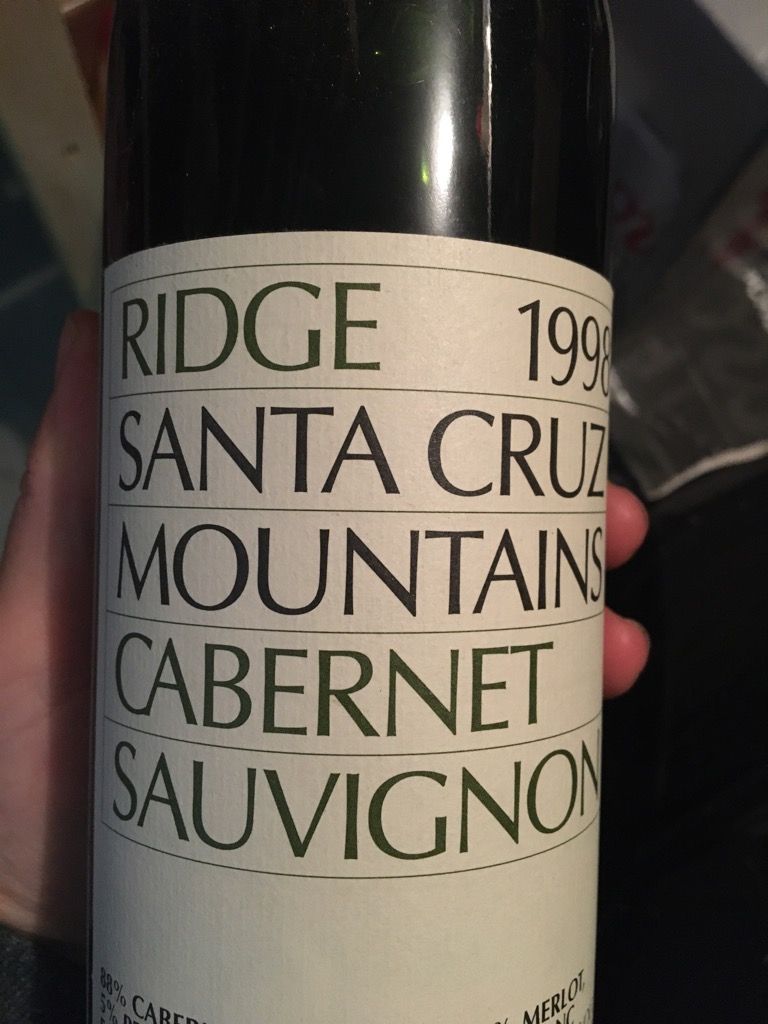
External search
Google (images)
Wine Advocate
Wine Spectator
Burghound
Wine-Searcher
Vintages
2014
2005
2004
2003
2002
2001
2000
1998
1997
1996
1995
1994
1993
1992
1991
1990
1989
1988
1987
1986
Show more
From this producer
Show all wines
All tasting notes
|
| Drinking Windows and Values |
| Drinking window: Drink between 2008 and 2019 (based on 49 user opinions) |
| Community Tasting History |
| Ridge Producer website | Wikipedia
Ridge Vineyards is a California winery specializing in premium Cabernet Sauvignon, Zinfandel, and Chardonnay wines. Ridge produces wine at two winery locations in northern California. The original winery facilities are located at an elevation of 2,300 feet (700 m) on Monte Bello Ridge in the Santa Cruz Mountains AVA near Cupertino, California. The other Ridge winery facilities are at Lytton Springs in the Dry Creek Valley AVA of Sonoma County.Cabernet SauvignonCabernet Sauvignon is probably the most famous red wine grape variety on Earth. It is rivaled in this regard only by its Bordeaux stablemate Merlot, and its opposite number in Burgundy, Pinot Noir. From its origins in Bordeaux, Cabernet has successfully spread to almost every winegrowing country in the world. It is now the key grape variety in many first-rate New World wine regions, most notably Napa Valley, Coonawarra and Maipo Valley. Wherever they come from, Cabernet Sauvignon wines always seem to demonstrate a handful of common character traits: deep color, good tannin structure, moderate acidity and aromas of blackcurrant, tomato leaf, dark spices and cedarwood.
Used as frequently in blends as in varietal wines, Cabernet Sauvignon has a large number of common blending partners. Apart from the obvious Merlot and Cabernet Franc, the most prevalent of these are Malbec, Petit Verdot and Carmenere (the ingredients of a classic Bordeaux Blend), Shiraz (in Australia's favorite blend) and in Spain and South America, a Cabernet – Tempranillo blend is now commonplace. Even the bold Tannat-based wines of Madiran are now generally softened with Cabernet SauvignonUSAAmerican wine has been produced since the 1500s, with the first widespread production beginning in New Mexico in 1628. Today, wine production is undertaken in all fifty states, with California producing 84% of all U.S. wine. The continent of North America is home to several native species of grape, including Vitis labrusca, Vitis riparia, Vitis rotundifolia, and Vitis vulpina, but the wine-making industry is based almost entirely on the cultivation of the European Vitis vinifera, which was introduced by European settlers. With more than 1,100,000 acres (4,500 km2) under vine, the United States is the fourth-largest wine producing country in the world, after Italy, Spain, and France.California2021 vintage: "Unlike almost all other areas of the state, the Russian River Valley had higher than normal crops in 2021, which has made for a wine of greater generosity and fruit forwardness than some of its stablemates." - Morgan Twain-Peterson Santa Cruz Mountains Santa Cruz Mountains Winegrowers Association | Wikipedia
Once referred to by wine writers as the Chaine d'Or -- or "golden chain" -- the Santa Cruz Mountains AVA sits above Silicon Valley, running along the craggy range next to the Pacific on some of the prettiest parts of Northern California. The area supports more than 75 wineries, despite being limited by geography and high land prices.
In 1981 the Santa Cruz Mountains Viticultural Appellation became federally recognized, one of the first American viticultural areas to be defined by geophysical and climatic factors. The appellation encompasses the Santa Cruz Mountain range, from Half Moon Bay in the north, to Mount Madonna in the south. The east and west boundaries are defined by elevation, extending down to 800 feet in the east and 400 feet in the west. |
|




